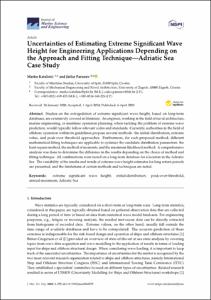| dc.contributor.author | Katalinić, Marko | |
| dc.contributor.author | Parunov, Joško | |
| dc.coverage.spatial | Adriatic Sea | en_US |
| dc.date.accessioned | 2023-06-06T21:11:55Z | |
| dc.date.available | 2023-06-06T21:11:55Z | |
| dc.date.issued | 2020 | |
| dc.identifier.citation | Katalinić, M. and Parunov, J. (2020) Uncertainties of Estimating Extreme Significant Wave Height for Engineering Applications Depending on the Approach and Fitting Technique—Adriatic Sea Case Study. Journal of Marine Science and Engineering, 8:00259, 18pp. DOI: https://doi.org/10.3390/jmse8040259 | en_US |
| dc.identifier.uri | https://repository.oceanbestpractices.org/handle/11329/2256 | |
| dc.description.abstract | Studies on the extrapolation of extreme significant wave height, based on long-term databases, are extensively covered in literature. An engineer, working in the field of naval architecture, marine engineering, or maritime operation planning, when tackling the problem of extreme wave prediction, would typically follow relevant codes and standards. Currently, authorities in the field of offshore operation within its guidelines propose several methods: the initial-distribution, extreme value, and peak-over threshold approaches. Furthermore, for each proposed method, different mathematical fitting techniques are applicable to optimize the candidate distribution parameters: the least-square method, the method of moments, and the maximum likelihood method. A comprehensive analysis was done to determine the difference in the results depending on the choice of method and fitting technique. All combinations were tested on a long-term database for a location in the Adriatic Sea. The variability of the results and trends of extreme wave height estimates for long return periods are presented, and the limitations of certain methods and techniques are noted. | en_US |
| dc.language.iso | en | en_US |
| dc.rights | Attribution 4.0 International | * |
| dc.rights.uri | http://creativecommons.org/licenses/by/4.0/ | * |
| dc.subject.other | Extreme significant wave height | en_US |
| dc.title | Uncertainties of Estimating Extreme Significant Wave Height for Engineering Applications Depending on the Approach and Fitting Technique—Adriatic Sea Case Study. | en_US |
| dc.type | Journal Contribution | en_US |
| dc.description.refereed | Refereed | en_US |
| dc.format.pagerange | 18pp. | en_US |
| dc.identifier.doi | https://doi.org/10.3390/jmse8040259 | |
| dc.subject.parameterDiscipline | Waves | en_US |
| dc.subject.dmProcesses | Data acquisition | en_US |
| dc.subject.dmProcesses | Data aggregation | en_US |
| dc.subject.dmProcesses | Data analysis | en_US |
| dc.bibliographicCitation.title | Journal of Marine Science and Engineering | en_US |
| dc.bibliographicCitation.volume | 8 | en_US |
| dc.bibliographicCitation.issue | Article 00259 | en_US |
| dc.description.sdg | 14.a | en_US |
| dc.description.methodologyType | Reports with methodological relevance | en_US |
| obps.contact.contactname | Marko Katalinić | |
| obps.contact.contactemail | marko.katalinic@pfst.hr | |
| obps.resourceurl.publisher | https://www.mdpi.com/2077-1312/8/4/259 | |
 Repository of community practices in Ocean Research, Applications and Data/Information Management
Repository of community practices in Ocean Research, Applications and Data/Information Management

